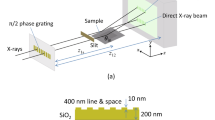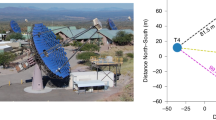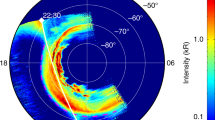Abstract
Starting with Galileo's observations of the Solar System, improvements of an order of magnitude in either the sensitivity or resolution of astronomical instruments have always brought revolutionary discoveries. The X-ray band of the spectrum, where exotic objects can have extremely high surface brightness1, is ideally suited for significant improvements in imaging, but progress has been impeded by a lack of optics of sufficiently high sensitivity and quality. Here we present an X-ray interferometer design that is practical for adaptation to astronomical observatories. Our prototype interferometer, having just under one millimetre of baseline, creates fringes at 1.25 keV with an angular resolution of 100 milliarcseconds. With a larger version in orbit it will be possible to resolve X-ray sources at 10-7 arcseconds, three orders of magnitude better than the finest-resolution images ever achieved on the sky (in the radio part of the spectrum) and over one million times better than the current best X-ray images. With such resolutions, we can study the environments of pulsars, resolve and then model relativistic blast waves, image material falling into a black hole, watch the physical formation of astrophysical jets, and study the dynamos of stellar coronae.
This is a preview of subscription content, access via your institution
Access options
Subscribe to this journal
Receive 51 print issues and online access
$199.00 per year
only $3.90 per issue
Buy this article
- Purchase on Springer Link
- Instant access to full article PDF
Prices may be subject to local taxes which are calculated during checkout


Similar content being viewed by others
References
Holt, S. & McCray, R. Spectra of cosmic X-ray sources. Annu. Rev. Astron. Astrophys. 20, 323– 365 (1982).
Weisskopf, M. C., O'Dell, S. L. & VanSpeybroeck, L. P. Advanced X-ray astrophysics facility (AXAF): An overview. Proc. Soc. Photo-Opt. Eng. 2805, 2– 7 (1996).
Bonse, U. & Hart, M. An X-ray interferometer. Appl. Phys. Lett. 6, 155–156 (1965).
Franks, A. X-ray interferometers. United States Patent and Trademark Office, Washington DC, Patent Number 4,174,478, 1–7 ( 1979).
Kellstrom, G. Experimentelle Untersuchungen uber Interferenz-Und Beugungserscheinungen bei Langwelligen Rontgenstrahlen. Nova Acta Soc. Sci. Upsala 8, 5–66 (1932).
Born, M. & Wolf, E. Principles of Optics 7th edn, 292–263 (Cambridge Univ. Press, Cambridge, 1999).
Polack, F., Joyeux, D., Svatos, J. & Phalippou, D. Applications of wavefront division interferometers in soft x-rays. Rev. Sci. Instrum. 66, 2180–2183 ( 1995).
Baldwin, J. E. et al. The first images from an optical aperture synthesis array. Astron. Astrophys. 306, L13– L16 (1996).
McKee, C. & Taylor, J. (eds) Astronomy and Astrophysics in the New Millennium (National Academy Press, Washington DC, 2000).
Siarkowski, M., Pres, P., Drake, S. A., White, N. E. & Singh, K. P. The Coronae of AR Lac II: The Spatial Structure. Astrophys. J. 473, 470– 482 (1996).
Acknowledgements
We thank N. White, D. Windt, J. Bixler, K. Doty, J. Carter, K. Herren, D. Goodman, J. Kolodziejczak, G. Zirnstein, T. Kester, M. Weisskopf and M. Karovska. This work was funded by NASA with additional technical support from the NASA Goddard Space Flight Center.
Author information
Authors and Affiliations
Corresponding author
Rights and permissions
About this article
Cite this article
Cash, W., Shipley, A., Osterman, S. et al. Laboratory detection of X-ray fringes with a grazing-incidence interferometer . Nature 407, 160–162 (2000). https://doi.org/10.1038/35025009
Received:
Accepted:
Issue Date:
DOI: https://doi.org/10.1038/35025009
This article is cited by
-
The high energy Universe at ultra-high resolution: the power and promise of X-ray interferometry
Experimental Astronomy (2021)
-
Lensing by exotic objects
General Relativity and Gravitation (2010)
-
Rapid and precise absolute distance measurements at long range
Nature Photonics (2009)
-
The development of astronomical interferometry
Experimental Astronomy (2009)
-
X-ray interferometry with transmissive beam combiners for ultra-high angular resolution astronomy
Experimental Astronomy (2009)
Comments
By submitting a comment you agree to abide by our Terms and Community Guidelines. If you find something abusive or that does not comply with our terms or guidelines please flag it as inappropriate.



